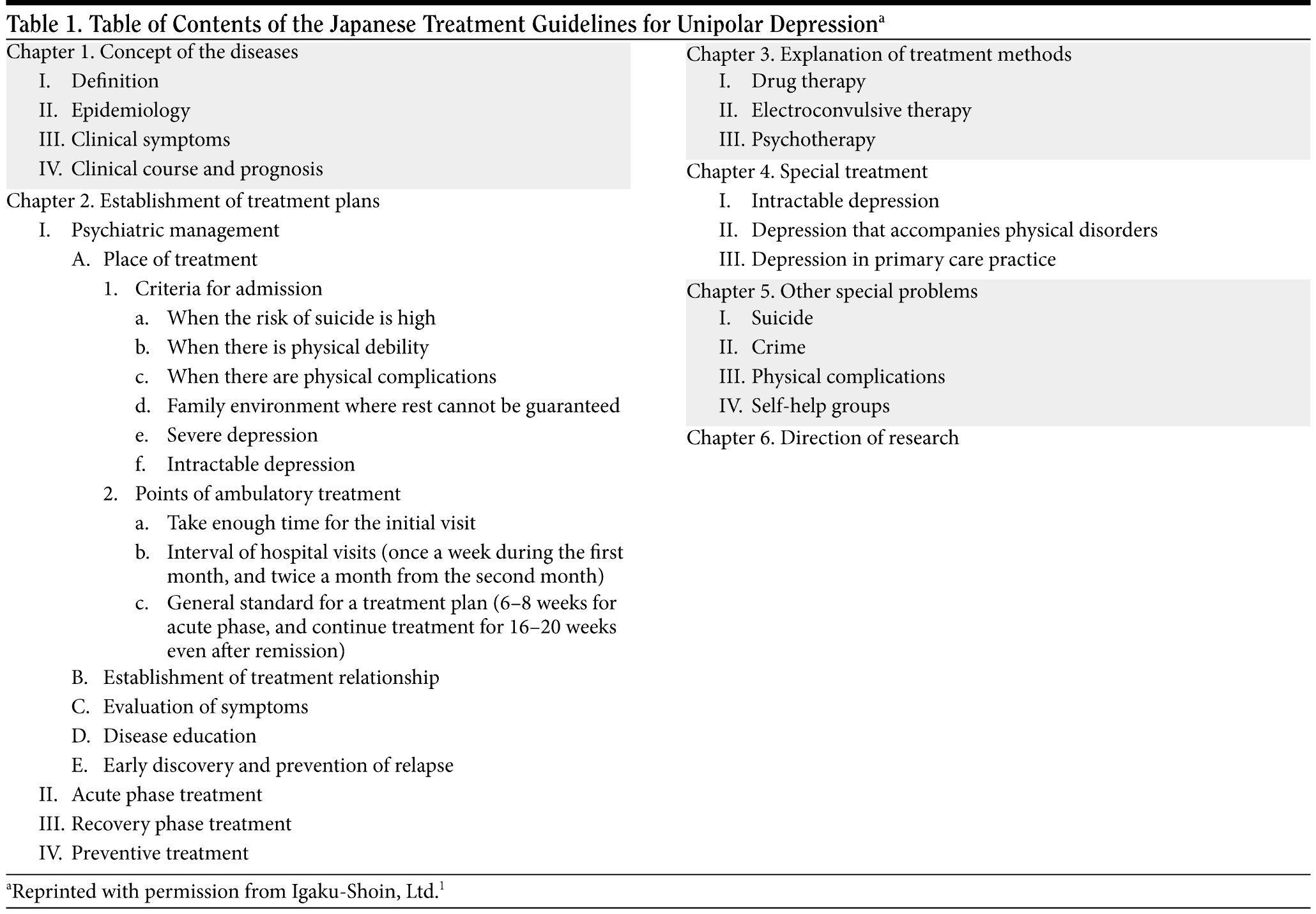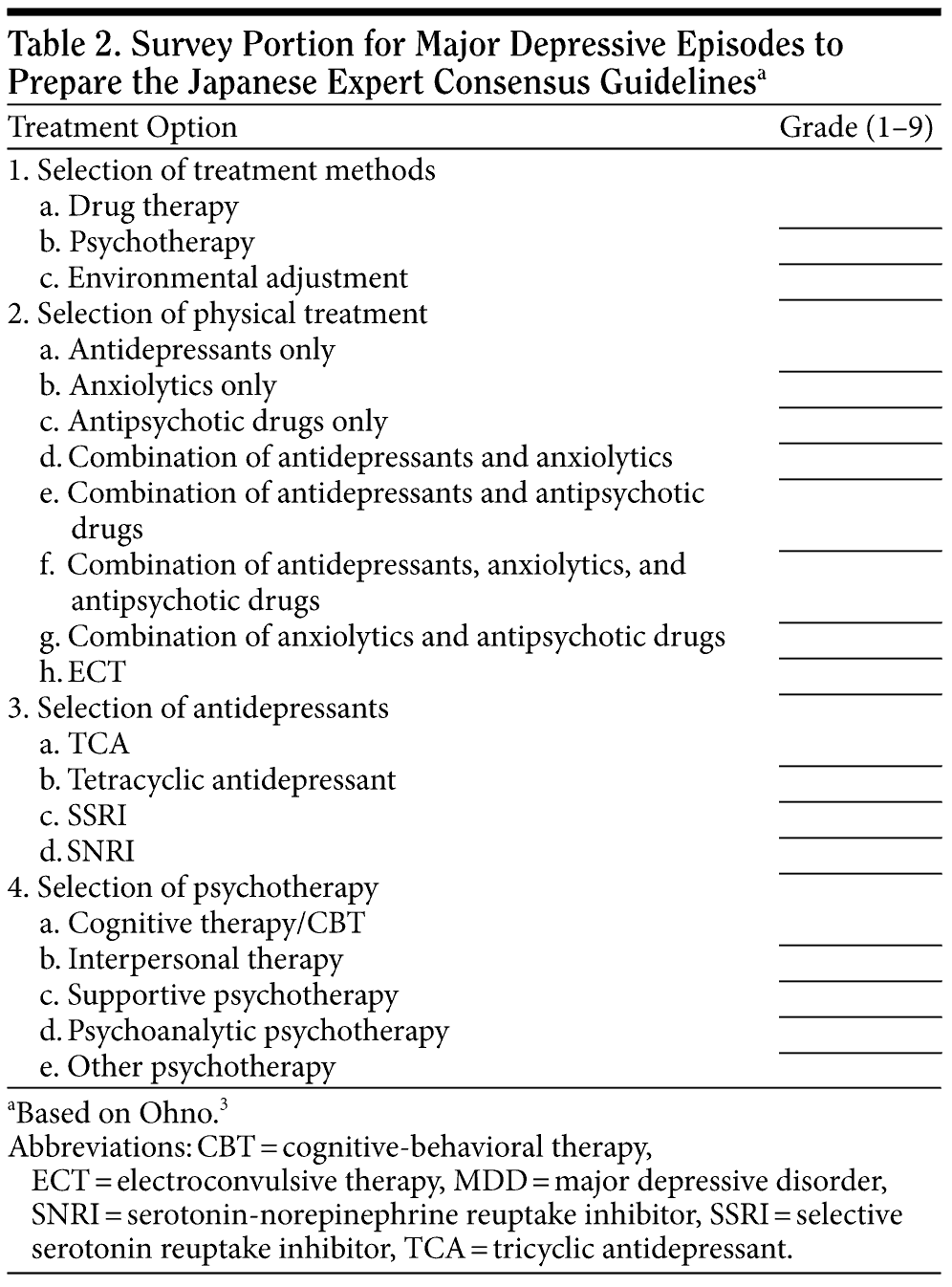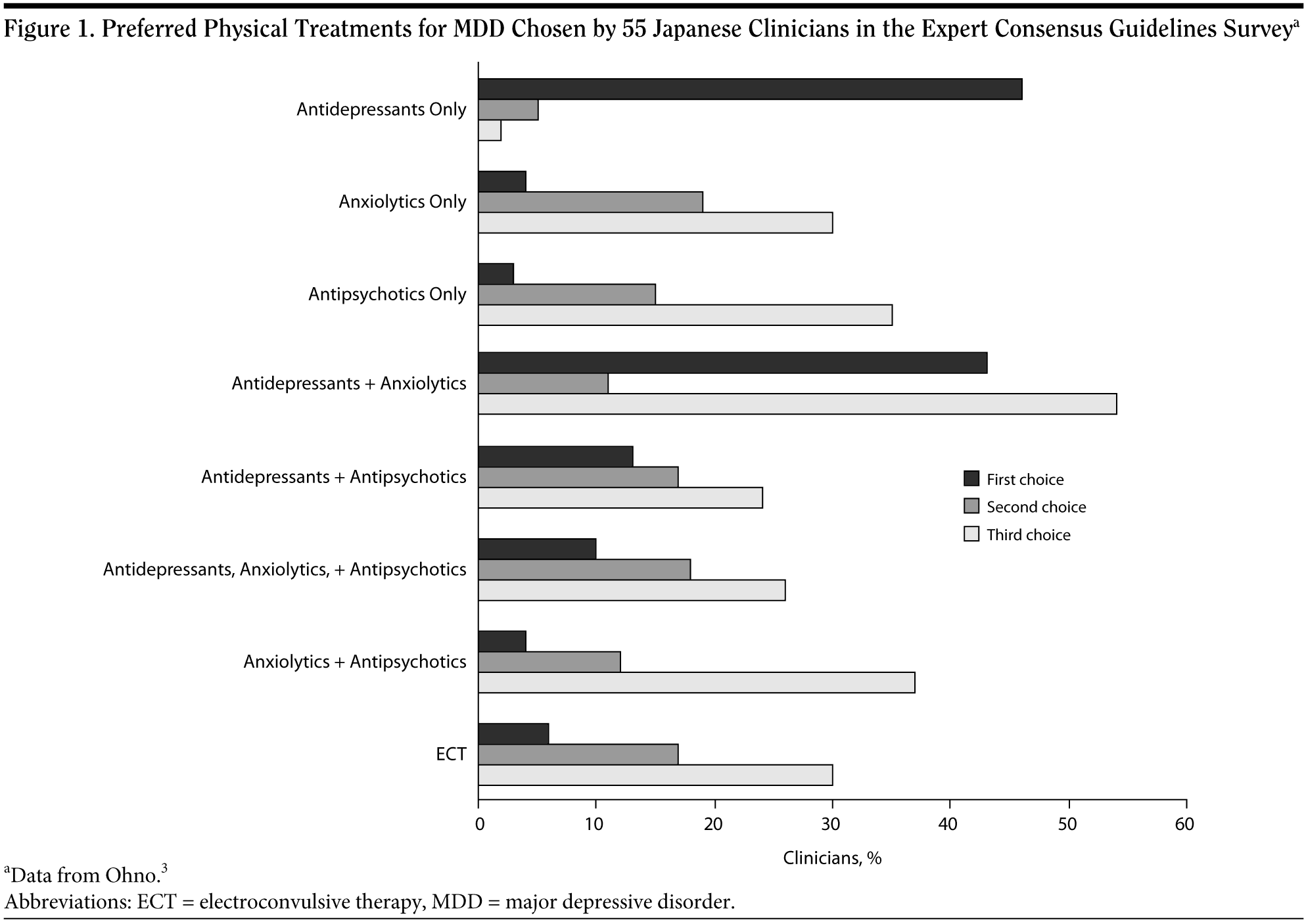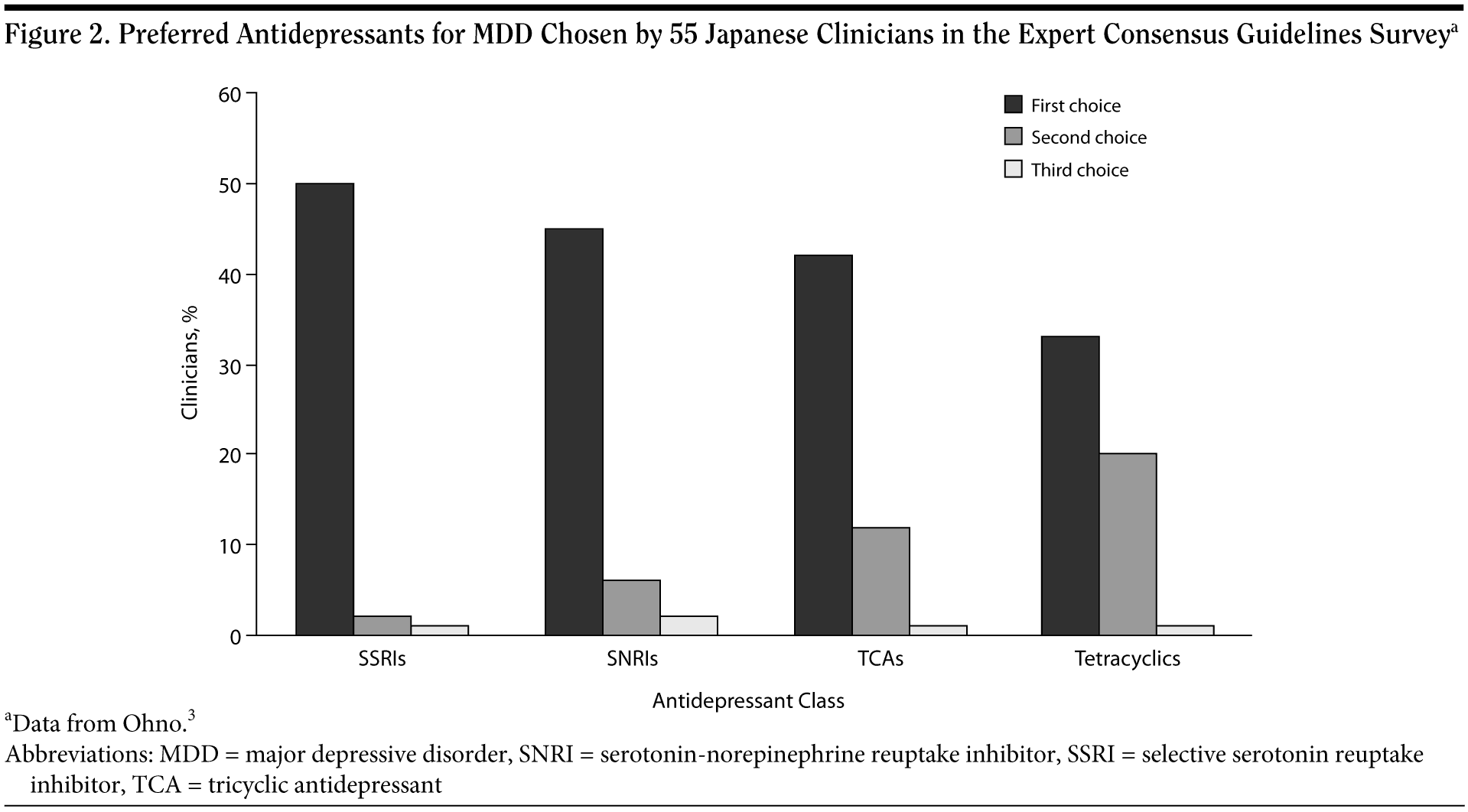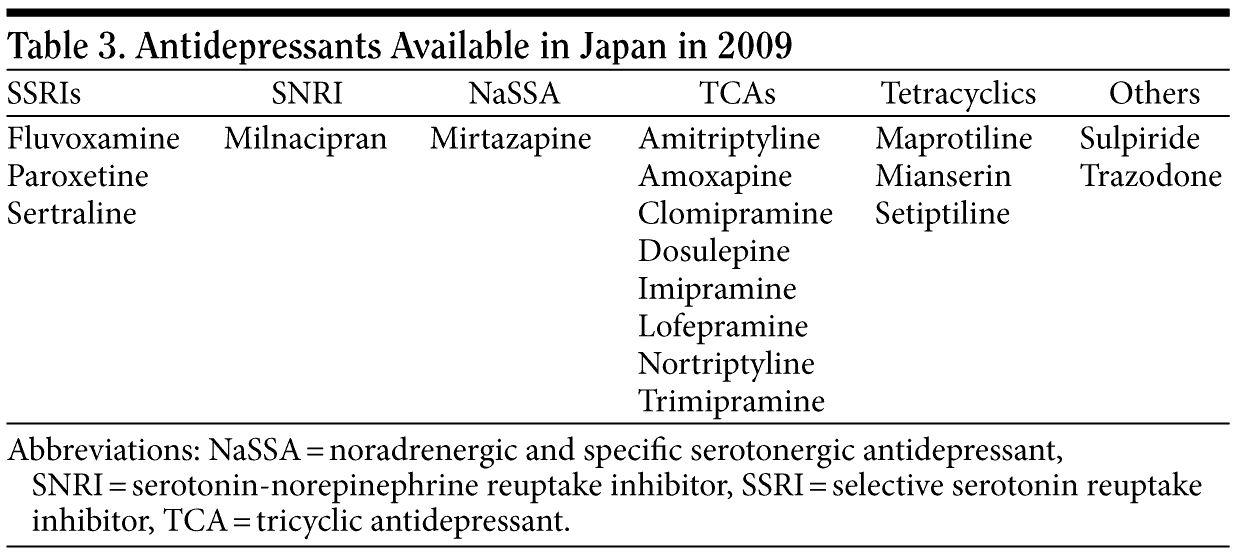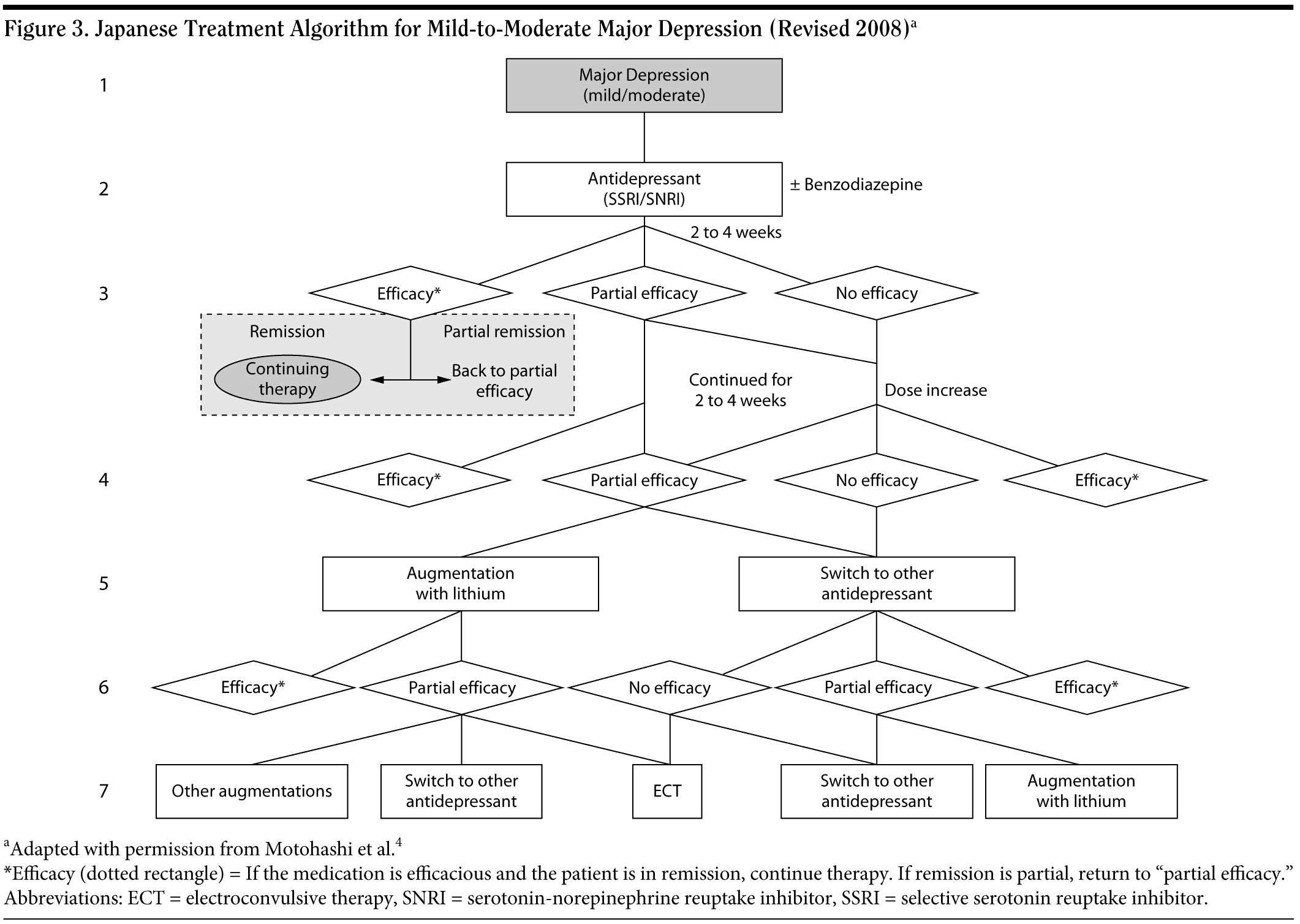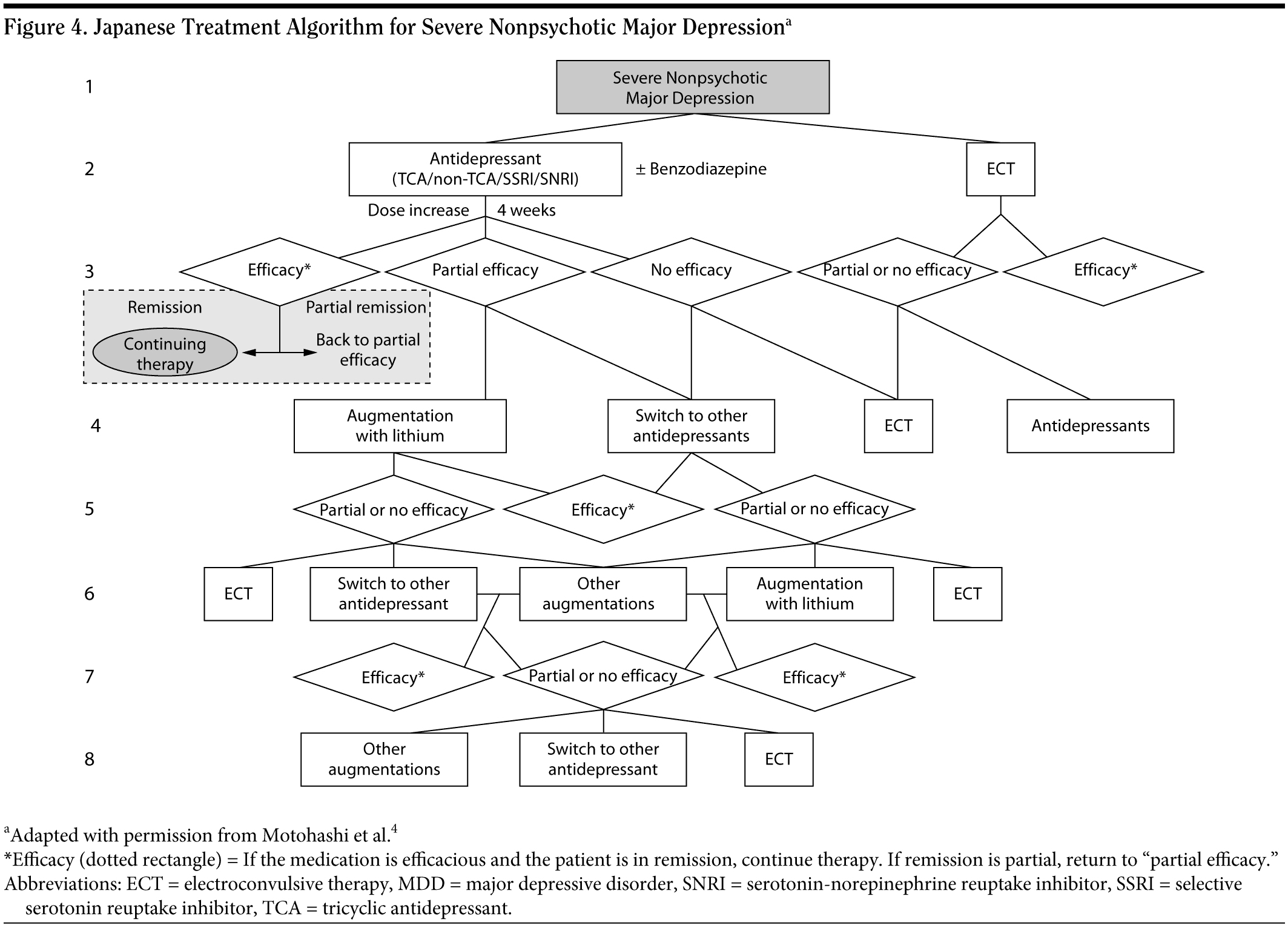Article Abstract
Japanese treatment guidelines, consensus guidelines, and treatment algorithms for managing patients with major depressive disorder (MDD) have been developed and/or updated in the past decade. The treatment guidelines, which are evidence-based, are the most detailed of the 3 types of guidance; they describe how to establish a treatment plan, treatment methods, and special problems such as intractable depression and suicide. The Japanese consensus guidelines were compiled from the results of a survey about treatment choices in MDD that was sent to members of the Japanese Society of Psychiatry and Neurology. Selective serotonin reuptake inhibitors and serotonin-norepinephrine reuptake inhibitors were the most common first-line treatments, followed by tricyclic antidepressants and tetracyclic antidepressants. The consensus guidelines are not evidence-based but are practical and easy to use. The Japanese treatment algorithm for MDD is a flowchart created in conjunction with the International Psychopharmacology Algorithm Project. The flowchart shows steps in treatment both for patients who respond to initial treatment and for those who need several trials of treatment. These 3 forms of guidance for managing patients with MDD in Japan are reviewed.
From the National Center of Neurology and Psychiatry, Tokyo, Japan.
This article is derived from the roundtable discussion “International Consensus Group on Depression,” which was held on September 1, 2009, in Tokyo, Japan, and supported by an educational grant from GlaxoSmithKline.
Dr Higuchi has no personal affiliations or financial relationships with any commercial interest to disclose relative to this article.
Corresponding author: Teruhiko Higuchi, MD, PhD, 4-1-1 Ogawa-Higashi, Kodaira, Tokyo 187-8551, Japan ([email protected]).
doi:10.4088/JCP.9058se1c.05gry
© Copyright 2010 Physicians Postgraduate Press, Inc.
In Japan, 3 types of guidance for use in the treatment of depression are available: treatment guidelines, consensus guidelines, and drug treatment algorithms. Psychiatrists and primary care physicians can consult these sources when formulating treatment regimens for their patients with major depressive disorder (MDD).
For Clinical Use
- Refer to treatment guidelines, consensus guidelines, and treatment algorithms when treating patients with major depressive disorder.
- Antidepressant monotherapy, particularly selective serotonin reuptake inhibitors and serotonin-norepinephrine reuptake inhibitors, is regarded as the best first-line treatment for depression as outlined by the Japanese expert consensus guidelines.
The Japanese treatment guidelines1 are similar to the American Psychiatric Association (APA) guidelines2 and were founded on evidence-based medicine. The Japanese expert consensus guidelines3 were developed from the results of a survey of specialists; the recommendations were derived from their expertise in clinical practice. The treatment algorithms,4 which are similar to the algorithms produced by the Texas Medication Algorithm Project (TMAP)5 in the United States, were compiled from evidence-based medicine, a survey of psychiatrists, and consensus of researchers. Treatment guidelines for major depression from the United States, Canada, and Europe are discussed by Jonathan R. T. Davidson, MD,6 in “Major Depressive Disorder Treatment Guidelines in America and Europe” in this supplement.
Treatment Guidelines
Few randomized controlled trials of depression treatment are conducted in Japan, so the evidence for the efficacy of particular treatments in this population is small. However, guidelines based on available evidence were developed. The content of the Japanese guidelines for the treatment of depression includes unipolar depression and bipolar disorder, but only unipolar depression is discussed in this supplement article. Table 1 outlines the 6 chapters about unipolar depression.1 In the guidelines, Chapter 2, “Establishment of Treatment Plans,” includes a section on psychiatric management, which discusses place of treatment.
In the Japanese health care system, patients with psychiatric disorders are often treated in hospitals rather than in the community; these patients are therefore referred to as inpatients who are resident in the hospital. However, in another health care system these patients might be treated as outpatients who visit the hospital for appointments; these patients are referred to as ambulatory patients. The Japanese health care system has been transitioning from treating psychiatric patients largely as inpatients in hospitals to treating many of them as ambulatory patients in the community.7
The criteria for inpatient admission include high suicide risk, physical problems, poor home environment, and greater severity of depression (see Table 1). If the patient is to be treated as an outpatient, the Japanese guidelines provide recommendations for the initial evaluation, the timing of follow-up visits, and the standard length of treatment phases. Outpatient follow-up visits should be once a week for the first month and twice a month from the second month onward. Acute phase treatment generally lasts at least 6 to 8 weeks and is followed by a continuation phase of 16 to 20 weeks after remission has been achieved.
Consensus Guidelines
The Japanese Expert Consensus Guidelines3 were compiled in a similar manner as the US Expert Consensus Guidelines for Bipolar Disorder.8 In the United States, 68 specialists in bipolar disorder were sent surveys that asked which treatment should be selected in different hypothetical cases. The responses were then analyzed, and drugs were classified by a 95% confidence interval in order of popularity. Using a similar method, a survey was sent to 150 members of the Japanese Society of Psychiatry and Neurology for the purpose of preparing expert consensus guidelines for depression. A portion of the survey is shown in Table 2.3 Survey recipients read, for example, the following description of a depressive episode: “When seeing a patient who has a major depressive disorder with depressive symptoms in the foreground, what type of treatment would you consider to be most desirable? Please choose the level of desirability of each treatment.” Respondents were then asked to show which treatments they thought were most desirable by selecting a grade from 1 to 9 “regardless of whether or not you would actually perform such treatment.” The grades were categorized as follows: 1 = inappropriate, I would never perform it; 2 = generally inappropriate, I would rarely perform it; 3 = somewhat inappropriate, probably the third choice; 4 = difficult to say, may be used as the second choice; 5 = difficult to say, may be used as the second choice when the first choice treatment does not work; 6 = difficult to say, frequently the second choice when the first choice treatment does not work; 7 = somewhat appropriate, frequently the first choice; 8 = more or less appropriate, almost always the first choice; 9 = extremely appropriate, most likely the best treatment.
Respondents graded the appropriateness of different treatment methods; physical treatments, including different classes of medication, combinations of medications, or electroconvulsive therapy (ECT); types of antidepressants; and types of psychotherapy. The grades were defined as follows: 7 to 9 were categorized as first choices with 9 being extremely appropriate and most likely the best treatment, 6 to 4 were second choices, and 3 to 1 were third choices with 1 being the least appropriate. Questions were prepared for different subtypes of depression, and responses were provided by 55 members.
The preferred physical treatments for patients in a major depressive episode are shown in Figure 1.3 The results indicate that antidepressant monotherapy was regarded as the best first choice treatment. Multiple-drug treatments for MDD were not supported unless the combination was an antidepressant plus an anxiolytic. The first-choice antidepressants were, in descending order, selective serotonin reuptake inhibitors (SSRIs), serotonin-norepinephrine reuptake inhibitors (SNRIs), tricyclic antidepressants (TCAs), and tetracyclic antidepressants (Figure 2).3
Antidepressants available in Japan in 2009 are shown in Table 3. Some of these medications, such as setiptiline and sulpiride, may be unfamiliar to clinicians outside of Japan. Three SSRIs are available: fluvoxamine, paroxetine, and sertraline. Milnacipran is the only SNRI available; duloxetine and venlafaxine are currently in clinical trials. Mirtazapine, a noradrenergic and specific serotonergic antidepressant (NaSSA), was approved recently. Newer agents are slow to be approved in Japan.9
Treatment Algorithms
In Japan, algorithms for drug treatment of various mood disorders were created in 199910,11 and were revised in 2008.4 Although the algorithms included ECT in addition to drug therapy, other nondrug treatments such as psychotherapy and light therapy were not included. The development of algorithms for the treatment of major Axis I psychiatric disorders was stimulated by the International Psychopharmacology Algorithm Project (IPAP), which is based in Tennessee in the United States. Conventionally, the term algorithm describes a process used to solve mathematical problems; however, it has since been used in various fields when procedures are presented in flowchart format.
The algorithms for mild and moderate depression and severe nonpsychotic depression are discussed here. The recommendations were derived from evidence-based medicine, which included as many studies conducted in Japan as possible, the surveyed opinions of about 200 psychiatrists in clinical practice from 19 institutes (13 university hospitals, 5 national institutes, and 1 private clinic) throughout Japan, and the consensus of the researchers. The algorithms for drug therapy are characterized not simply by flowcharts but also by explanatory notes, references, and the level of evidence used as the basis for treatment choices.
Japanese Algorithm for the Treatment of Mild and Moderate Depression
The Japanese algorithm for the treatment of mild and moderate depression is shown in Figure 3.4 Several factors influence the selection of the treatment strategy and the initial therapy. These factors include the age of the patient; the intensity of the patient’s anxiety, agitation, or suicidal ideation; whether the patient is an inpatient or an outpatient; comorbid physical or mental ailments; concurrent medications; and history of pharmacotherapy, especially the effectiveness or harmful effects of drugs taken during past episodes of MDD.
In patients with mild or moderate MDD, the recommended first-choice antidepressant was an SSRI or SNRI. In principle, the algorithm stipulates the administration of a single antidepressant, but it does permit the combined use of benzodiazepines during the early period (up to the first 4 weeks) of therapy for depression accompanied by insomnia, anxiety, and, in particular, agitation. If the first-line treatment is effective and the patient is judged to be in remission, the patient should receive continuation therapy with the same drug at the effective dose for at least 4 to 6 months. Naturalistic research12,13 has suggested that Japanese patients often receive inadequately dosed antidepressant treatment during the acute, continuation, and maintenance phases. If the initial antidepressant therapy is ineffective, even at the maximum dosage, the following choices are available: switch to another antidepressant, augment the initial antidepressant with another type of agent, combine 2 antidepressants, or implement ECT.
A study14 comparing algorithm-guided treatment with treatment as usual for mild or moderate MDD in Japan found that the use of the algorithm increased remission by about 10% and halved the median number of days to remission. However, most patients who did not achieve remission after the first or second step dropped out of treatment, so the later algorithm steps were rarely tested.
Japanese Algorithm for the Treatment of Severe Nonpsychotic Depression
Severely depressed patients are generally hospitalized. The algorithm for severe nonpsychotic major depression is different from the algorithm for mild and moderate depression in that it includes TCAs, other antidepressants, and ECT among the first-line treatments (Figure 4).4 Patients at high risk of suicide or those who are severely ill can benefit from ECT. If the first choice of treatment is not effective or is partially effective, augmentation with lithium or switching to another medication or ECT can be selected as second- or third-line treatments.
Summary
The 3 kinds of Japanese guidance for treating MDD have different characteristics that make them useful for different purposes. For example, the treatment guidelines and psychopharmacology algorithms are evidence-based, but the available evidence in Japan is limited. The consensus guidelines are based on the experience of clinicians but may not be supported by evidence.
The treatment guidelines are encyclopedic in their coverage, but this means the volume is large and revisions are time-consuming. The consensus guidelines are short and convenient to use, but revision nevertheless is time-consuming because it requires seeking consensus. The treatment algorithms are brief, practical, and easy to revise. However, algorithms do not provide instructions on how to switch from one drug to another.15
Although these resources have been updated to include recently available medications, the treatment of MDD in Japan still has some limitations. Patients may have little access to psychiatric care for depression because physician education on the subject is lacking. Japan does not have true primary care physicians with training in a wide range of psychiatric disorders. Some medical students learn about mood disorders, but others do not, and therefore some medical practitioners have no training in treating patients with MDD.
Discussion
Professor Nutt: How long is undergraduate training for medicine in Japan?
Dr Higuchi: Undergraduate training is 6 years at a university and 1 to 2 years of clinical practice after graduation.
Dr Kanba: In some universities, students receive 2 years of clinical practice, but typically they receive 1 year.
Professor Nutt: During the 1 or 2 years of undergraduate clinical practice in Japan, how long do medical students study psychiatry?
Dr Higuchi: Two weeks for undergraduate clinical practice in psychiatry.
Dr Zhang: In China, also, most universities offer 2 weeks of undergraduate clinical practice in psychiatry.
Dr Higuchi: At the postgraduate level, students undergo clinical practice for 1 month, during which they gain experience with 4 different psychiatric disorders, one of which could be mood disorders.
Professor Nutt: In the United Kingdom, the length of psychiatric training varies, but it is at least 6 weeks because it is regarded as a key part of medicine. The way we justify that length is that, in primary care practices, so much of what practitioners do is psychiatry.
Dr Papakostas: I would argue that students need more time than 2 weeks because antidepressants may take 4 to 6 weeks to start working.
Dr Karamustafalıoğlu: Do the target users like these algorithms and use them in their own practices?
Dr Higuchi: Young psychiatrists in some universities or hospitals use them, but algorithms are not very popular yet. Resistant clinicians need to be encouraged to incorporate the algorithms into their practices.
Drug Names: clomipramine (Anafranil and others), duloxetine (Cymbalta), fluvoxamine (Luvox and others), imipramine (Tofranil and others), lithium (Eskalith, Lithobid, and others), milnacipran (Savella), mirtazapine (Remeron and others), nortriptyline (Pamelor, Aventyl, and others), paroxetine (Paxil, Pexeva, and others), sertraline (Zoloft and others), trimipramine (Surmontil and others), venlafaxine (Effexor and others).
Disclosure of off-label usage: The author has determined that, to the best of his knowledge, dosulepine, lithium, lofepramine, mianserin, setiptiline, and sulpiride are not approved by the US Food and Drug Administration for the treatment of major depressive disorder.
References
1. Kamijima K, for the Committee on Psychiatry. The Guidelines for the Treatment of Mood Disorders. Tokyo, Japan: Igaku-Shoin Ltd; 2004.
2. American Psychiatric Association. Treatment of patients with major depressive disorder: practice guidelines. 2nd ed. http://www.psychiatryonline.com/pracGuide/pracGuideTopic_7.aspx. Published 2000. Accessed March 9, 2010.
3. Ohno H. The survey of experts for developing the expert consensus guidelines for the treatment of depression [in Japanese]. In: Kashima H, principal investigator. The Research on Developing Guidelines for the Treatment of Mental Disorders. Final Report. Published 2003. http://mhlw-grants.niph.go.jp/niph/search/NIST00.do. Accessed March 9, 2010.
4. Motohashi N, Shioe K, Nakamura J, et al. Revised psychopharmacological algorithms for the treatment of mood disorders in Japan. Int J Psychiatry Clin Pract. 2008;12(1):11-18. doi:10.1080/13651500701330791
5. Crismon ML, Trivedi MH, Pigott TA, et al. The Texas Medication Algorithm Project: report of the Texas consensus conference panel on medication treatment of major depressive disorder. J Clin Psychiatry. 1999;60(3):142-156. PubMed
6. Davidson JRT. Major depressive disorder treatment guidelines in America and Europe. J Clin Psychiatry. 2010;71(suppl E1):e04.
7. Mizuno M, Suzuki M, Matsumoto K, et al. Clinical practice and research activities for early psychiatric intervention at Japanese leading centres. Early Interv Psychiatry. 2009;3(1):5-9. doi:10.1111/j.1751-7893.2008.00104.x
8. Frances A, Docherty JP, Kahn DA. The Expert Consensus Guidelines Series: treatment of bipolar disorder. J Clin Psychiatry. 1996;57(suppl 12A):1-88.
9. Kanba S. Disparities in drug development: the Japanese paradox. J Psychiatry Neurosci. 1999;24(1):13-14. PubMed
10. Higuchi T, Fujiwara Y, Iwanami A, et al. Algorithm for the treatment of mood disorders in Japan. Int J Psychiatry Clin Pract. 1999;3(4):277-285. doi:10.3109/13651509909068396
11. Shioe K, Kanba S. Algorithms for the pharmacotherapy of major depression. Psychiatry Clin Neurosci. 1999;53(suppl):S77-S82. PubMed
12. Fujita A, Azuma H, Kitamura T, et al. Adequacy of continuation and maintenance treatments for major depression in Japan. J Psychopharmacol. 2008;22(2):153-156. doi:10.1177/0269881107079049 PubMed
13. Furukawa TA, Kitamura T, Takahashi K. Treatment received by depressed patients in Japan and its determinants: naturalistic observation from a multi-center collaborative follow-up study. J Affect Disord. 2000;60(3):173-179. doi:10.1016/S0165-0327(99)00175-5 PubMed
14. Yoshino A, Sawamura T, Kobayashi N, et al. Algorithm-guided treatment versus treatment as usual for major depression. Psychiatry Clin Neurosci. 2009;63(5):652-657. doi:10.1111/j.1440-1819.2009.02009.x PubMed
15. Nomura S, Sawamura T, Kobayashi N, et al. Medication algorithm for mood disorders: present status and future direction in Japan. Int J Psychiatry Clin Pract. 2004;8(3):139-145. doi:10.1080/13651500410005432-1
